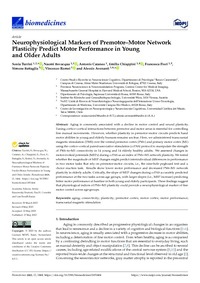Mostrar el registro sencillo de la publicación
Neurophysiological markers of premotor–motor network plasticity predict motor performance in young and older adults
| dc.contributor.author | Turrini, Sonia | |
| dc.contributor.author | Bevacqua, Naomi | |
| dc.contributor.author | Cataneo, Antonio | |
| dc.contributor.author | Chiappini, Emilio | |
| dc.contributor.author | Fiori, Francesca | |
| dc.contributor.author | Battaglia, Simone | |
| dc.contributor.author | Romei, Vincenzo | |
| dc.contributor.author | Avenanti, Alessio | |
| dc.date.accessioned | 2023-07-10T19:53:21Z | |
| dc.date.available | 2023-07-10T19:53:21Z | |
| dc.date.issued | 2023 | |
| dc.identifier.uri | http://repositorio.ucm.cl/handle/ucm/4861 | |
| dc.description.abstract | Aging is commonly associated with a decline in motor control and neural plasticity. Tuning cortico–cortical interactions between premotor and motor areas is essential for controlling fine manual movements. However, whether plasticity in premotor–motor circuits predicts hand motor abilities in young and elderly humans remains unclear. Here, we administered transcranial magnetic stimulation (TMS) over the ventral premotor cortex (PMv) and primary motor cortex (M1) using the cortico–cortical paired-associative stimulation (ccPAS) protocol to manipulate the strength of PMv-to-M1 connectivity in 14 young and 14 elderly healthy adults. We assessed changes in motor-evoked potentials (MEPs) during ccPAS as an index of PMv-M1 network plasticity. We tested whether the magnitude of MEP changes might predict interindividual differences in performance in two motor tasks that rely on premotor-motor circuits, i.e., the nine-hole pegboard test and a choice reaction task. Results show lower motor performance and decreased PMv-M1 network plasticity in elderly adults. Critically, the slope of MEP changes during ccPAS accurately predicted performance at the two tasks across age groups, with larger slopes (i.e., MEP increase) predicting better motor performance at baseline in both young and elderly participants. These findings suggest that physiological indices of PMv-M1 plasticity could provide a neurophysiological marker of fine motor control across age-groups. | es_CL |
| dc.language.iso | en | es_CL |
| dc.rights | Atribución-NoComercial-SinDerivadas 3.0 Chile | * |
| dc.rights.uri | http://creativecommons.org/licenses/by-nc-nd/3.0/cl/ | * |
| dc.source | Biomedicines, 11(5), 1464 | es_CL |
| dc.subject | Aging | es_CL |
| dc.subject | Connectivity | es_CL |
| dc.subject | Plasticity | es_CL |
| dc.subject | Premotor cortex | es_CL |
| dc.subject | Motor cortex | es_CL |
| dc.subject | Motor performance | es_CL |
| dc.subject | Transcranial magnetic stimulation | es_CL |
| dc.title | Neurophysiological markers of premotor–motor network plasticity predict motor performance in young and older adults | es_CL |
| dc.type | Article | es_CL |
| dc.ucm.indexacion | Scopus | es_CL |
| dc.ucm.uri | mdpi.com/2227-9059/11/5/1464 | es_CL |
| dc.ucm.doi | doi.org/10.3390/biomedicines11051464 | es_CL |



